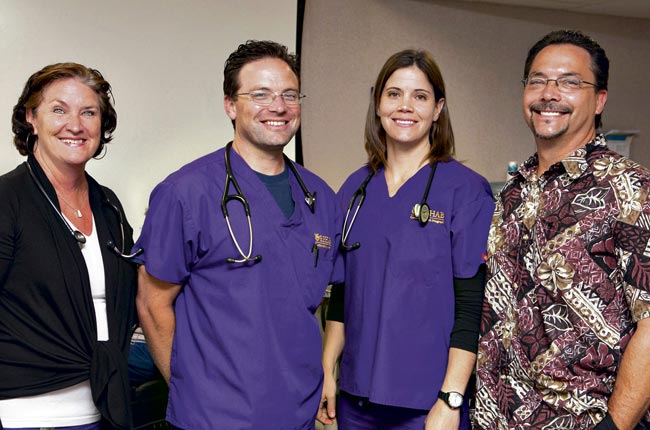Attending To Cardiac Health
SUSIE GABRIEL & CHRIS MAUSOLF
Rehabilitation Hospital of the Pacific (REHAB)
Where did you receive your schooling and training?
Gabriel: I have a master’s in nursing from UH.
Mausolf: I have a Bachelor of Science in health care administration and I am a licensed cardiovascular technologist.
How long have you been practicing?
Gabriel: More than 20 years. I’m now the registered nurse manager with REHAB’s new Cardiac Health Program.
Mausolf: More than 25 years and I am the Cardiac Health Program director.
How new is the Cardiac Health Program?
Gabriel: We started in March. Cardiac rehab is not new, it just hasn’t been done in the Islands for about eight years because of reimbursement issues, but that has improved. Cardiac rehab is becoming a recognized need based on the amount of heart disease, both nationally and in the Islands. We currently have 60 patients enrolled in the program.
When we get a referral from a physician, we bring in the patient for an assessment. We provide education on exercise, cardiac health, nutrition and diet. We get them back to their base point or healthier than they were before their cardiac event. A cardiac event could be a heart attack, open-heart surgery, congestive heart failure or coronary artery disease – these are some of the most common patients that we see.
After surgery, it’s about getting them back to good health. If they haven’t had surgery, it’s getting them in shape and in health so they don’t have to have surgery.
Mausolf: Most of these patients have had heart attacks or some type of cardiovascular disease. After the procedure that will help them – surgery, angioplasty or stenting – we try to get them at least to where they were before the episode, but more times than not better than they were. It doesn’t just encompass exercise. There are so many things we do in relationship to how their medicine is taken. We’re always in contact with all of the physicians they see – their primary care physicians, their specialists.
What are the main issues you address with cardiac health patients?
Gabriel: Exercise, diet, nutrition and smoking cessation are some of the main issues. We do one-on-one counseling as well as have group classes. For instance, we just brought in our dieti-cian and had a class on pre-diabetes and diabetic diets because a lot of our patients are diabetic. In our one-on-one counseling we also talk about depression, because 80 percent of our patients who have had some type of cardiac event suffer from depression. About two weeks into the therapy, the patients start to feel better.
Mausolf: They get their confidence back. They find out that they don’t have to just sit on the couch. That’s one of the huge benefits of having a program like this. For eight years now they haven’t had something like this anywhere in the state, so it’s nice that we can introduce this again and see the results so fast. The patients are just bubbly: “Wow, I can go to the beach, I can go to the mall and I don’t have to worry about having another heart attack.”
We work them out here on a monitor so we can seewhat’s going on with them. We test them so that we can push that limit of where they are physically.
Gabriel: They also bond with the other patients because they’re all in the same boat. They’re able to socialize and they feel accepted.
This is the only facility of its kind in the state?
Mausolf: There are places that offer cardiac rehab in the state, but they’re not structured programs like ours. We are under certification, so we’re very regimented in what we do and how we do it. We also send our data to a national registry so we can benchmark our program against the rest of the country.
Anything you’d like to add?
Gabriel: Our youngest patient is 38 and our oldest is 89, so cardiac concerns do affect everybody, every generation. Even fairly young people can have cardiac problems, but they don’t necessarily pay attention to those warning signs, thinking it can’t be their heart.
Mausolf: We see patients who are noncompliant. They have a poor diet, they smoke, but we also see patients who are world-class athletes. Cardiac disease is so far reaching.
How does an athlete end up with heart disease?
Gabriel: It can be heredity. It also can be diet-related, with them thinking, “I’ve worked out so much I can eat anything I want.” This is not true.
What are some warning signs for cardiac disease?
Gabriel: Chest pain or tightness radiating to jaw or shoulder, indigestion, shortness of breath with or without exertion, high blood pressure, irregular heart beat and low back pain or stomach issues (especially in women).
Mausolf: There’s a huge difference in how men and women present with heart disease. Women are so under-diagnosed. They will typically blow off the signs and symptoms because they’re so busy taking care of everybody else. This causes them not to pay attention to the warning signs. This is an underserved area that needs more focus.







